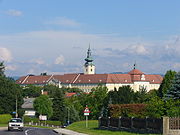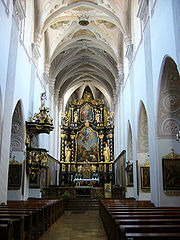
Seitenstetten Abbey
Encyclopedia

Seitenstetten
Seitenstetten is a town in the district of Amstetten in Lower Austria in Austria.One Udalschalk or Udiskalk, first mentioned in 1109, founded a monastery there in 1112 and gave all of his properties in Seitenstetten, Grünbach, Heft and Stille . In 1114, Benedictine monks from Göttweig Abbey were...
in the Mostviertel
Mostviertel
Mostviertel is the southwestern quarter of the four quarters of Lower Austria . It is bordered on the north by the Danube and to the south and west by the state borders of Styria and Upper Austria respectively...
region of Lower Austria
Lower Austria
Lower Austria is the northeasternmost state of the nine states in Austria. The capital of Lower Austria since 1986 is Sankt Pölten, the most recently designated capital town in Austria. The capital of Lower Austria had formerly been Vienna, even though Vienna is not officially part of Lower Austria...
.
History
The monastery was founded in 1112 by Udalschalk, or Udiskalk, a relative of Bishop Ulrich of PassauPassau
Passau is a town in Lower Bavaria, Germany. It is also known as the Dreiflüssestadt or "City of Three Rivers," because the Danube is joined at Passau by the Inn from the south and the Ilz from the north....
, to which he gave all his estates as an endowment. In 1114 the new foundation was settled by monks from Göttweig Abbey
Göttweig Abbey
Göttweig Abbey is a Benedictine monastery near Krems in Lower Austria.-History:Göttweig Abbey was founded as a monastery of canons regular by Blessed Altmann, Bishop of Passau...
. Bishop Ulrich dedicated the church in 1116 and granted the abbey the large parish of Aschbach. In 1142 it also received the large parish of Wolfsbach. Out of these two original parishes were formed the fourteen modern parishes for which the abbey is still responsible.
In about 1180 Archbishop Wichmann of Magdeburg granted the abbey the extensive woodlands on the Ybbs
Ybbs
Ybbs is a river in Lower Austria, and in Austria also the common short form to designate the little town Ybbs an der Donau.Its source is located on the Zellerrain Pass near Mariazell...
, with the duty of setting up a cell there and celebrating divine service in perpetuity. There is also some indication in the first century of the abbey's existence that there was already a school.
Despite many setbacks, including two serious fires and many disputes over property, the abbey gradually developed. In 1347 the community had 22 members. After a lengthy period of decline Abbot Benedikt I, formerly prior of the Schottenstift in Vienna
Vienna
Vienna is the capital and largest city of the Republic of Austria and one of the nine states of Austria. Vienna is Austria's primary city, with a population of about 1.723 million , and is by far the largest city in Austria, as well as its cultural, economic, and political centre...
, introduced the Melk Reforms
Melk Abbey
Melk Abbey or Stift Melk is an Austrian Benedictine abbey, and one of the world's most famous monastic sites. It is located above the town of Melk on a rocky outcrop overlooking the river Danube in Lower Austria, adjoining the Wachau valley....
at Seitenstetten, thus bringing about a revival in its spiritual and cultural life. This abbot had a chapel built and dedicated in 1440 on the Sonntagberg and so established the Sonntagberger Pilgrimage under the control and protection of the abbey.
Thereafter the abbey was hard hit by the Hungarian
Hungary
Hungary , officially the Republic of Hungary , is a landlocked country in Central Europe. It is situated in the Carpathian Basin and is bordered by Slovakia to the north, Ukraine and Romania to the east, Serbia and Croatia to the south, Slovenia to the southwest and Austria to the west. The...
disturbances associated with Matthias Corvinus, the Turkish
Ottoman Empire
The Ottoman EmpireIt was usually referred to as the "Ottoman Empire", the "Turkish Empire", the "Ottoman Caliphate" or more commonly "Turkey" by its contemporaries...
taxes and above all the Reformation
Protestant Reformation
The Protestant Reformation was a 16th-century split within Western Christianity initiated by Martin Luther, John Calvin and other early Protestants. The efforts of the self-described "reformers", who objected to the doctrines, rituals and ecclesiastical structure of the Roman Catholic Church, led...
; the number of monks declined sharply.
Not until the time of Abbot Christoph Held (1572–1602), with the powerful support of the Imperial Council, was any beginning of spiritual revival possible. Under the abbots that followed, the art of the Baroque
Baroque
The Baroque is a period and the style that used exaggerated motion and clear, easily interpreted detail to produce drama, tension, exuberance, and grandeur in sculpture, painting, literature, dance, and music...
made its appearance, and the number of monks was augmented by Bavaria
Bavaria
Bavaria, formally the Free State of Bavaria is a state of Germany, located in the southeast of Germany. With an area of , it is the largest state by area, forming almost 20% of the total land area of Germany...
ns and Swabia
Swabia
Swabia is a cultural, historic and linguistic region in southwestern Germany.-Geography:Like many cultural regions of Europe, Swabia's borders are not clearly defined...
ns. But only after the Thirty Years' War
Thirty Years' War
The Thirty Years' War was fought primarily in what is now Germany, and at various points involved most countries in Europe. It was one of the most destructive conflicts in European history....
did Abbot Gabriel Sauer (1648–74) finally succeed in stabilising the abbey economically and then in bringing about a true religious renewal.

Jakob Prandtauer
Jakob Prandtauer was an Austrian Baroque architect....
(succeeded in the work by his nephew Josef Munggenast
Josef Munggenast
Josef Munggenast was an Austrian architect and masterbuilder of the Baroque period.Munggenast was born in Schnann in Tyrol, the nephew of Jakob Prandtauer, who advanced his career and whose influence marked his style for the whole of his life.From 1717 Munggenast was master mason in Sankt Pölten...
) to build the magnificent Pilgrimage Church of the Holy Trinity on the Sonntagberg. The early Gothic
Gothic architecture
Gothic architecture is a style of architecture that flourished during the high and late medieval period. It evolved from Romanesque architecture and was succeeded by Renaissance architecture....
abbey church was lavishly refurbished, including work by Franz Joseph Feuchtmayer
Franz Joseph Feuchtmayer
Franz Joseph Feuchtmayer was a member of the German Feuchtmayer family of Baroque artists of the Wessobrunner School.Feuchtmayer was born in Wessobrunn Abbey...
. Between 1718 and 1747 the Baroque conventual buildings that still stand today were constructed. Ceiling frescoes in the Marble Hall (1735) and the library (1740) were executed by Paul Troger
Paul Troger
Paul Troger was an Austrian painter, draughtsman and printmaker of the late Baroque period. Troger's illusionistic ceiling paintings in fresco are notable for their dramatic vitality of movement and their palette of light colors.Paul Troger’s style, particularly in his frescoes, dominated Austrian...
, while those on the grand staircase were by Bartolomeo Altomonte
Bartolomeo Altomonte
Bartolomeo Altomonte, also known as Bartholomäus Hohenberg , was an Austrian baroque painter who specialized in large scale frescoes...
. The summer refectory contains 19 pictures by Kremser Schmidt.
The finance for these lavish works came principally from the abbey's copper mines in the Radmer
Radmer
Radmer is a municipality in the district of Leoben in Styria, Austria....
(Styria) and the brass foundry at Reichraming
Reichraming
Reichraming is a municipality in the district of Steyr-Land in Upper Austria, Austria. Many people of the municipality speak German.-References:...
(Upper Austria
Upper Austria
Upper Austria is one of the nine states or Bundesländer of Austria. Its capital is Linz. Upper Austria borders on Germany and the Czech Republic, as well as on the other Austrian states of Lower Austria, Styria, and Salzburg...
).
After the difficulties of the anti-monastic policies of Emperor Joseph II
Joseph II, Holy Roman Emperor
Joseph II was Holy Roman Emperor from 1765 to 1790 and ruler of the Habsburg lands from 1780 to 1790. He was the eldest son of Empress Maria Theresa and her husband, Francis I...
and of the Napoleonic wars
Napoleonic Wars
The Napoleonic Wars were a series of wars declared against Napoleon's French Empire by opposing coalitions that ran from 1803 to 1815. As a continuation of the wars sparked by the French Revolution of 1789, they revolutionised European armies and played out on an unprecedented scale, mainly due to...
, the abbey gradually regained its strength through the 19th century, until the time of Abbot Theodor Springer (1920–58), who not only brought the abbey safely through the economic crisis after World War I
World War I
World War I , which was predominantly called the World War or the Great War from its occurrence until 1939, and the First World War or World War I thereafter, was a major war centred in Europe that began on 28 July 1914 and lasted until 11 November 1918...
but also through the National Socialist
Nazism
Nazism, the common short form name of National Socialism was the ideology and practice of the Nazi Party and of Nazi Germany...
period and World War II
World War II
World War II, or the Second World War , was a global conflict lasting from 1939 to 1945, involving most of the world's nations—including all of the great powers—eventually forming two opposing military alliances: the Allies and the Axis...
without its being dissolved, as so many other monasteries were.
Since the war more renovations have taken place both to the Pilgrimage Church and to the structure of the abbey itself.
Besides the major works of art and architecture mentioned previously, there are also the Romanesque
Romanesque architecture
Romanesque architecture is an architectural style of Medieval Europe characterised by semi-circular arches. There is no consensus for the beginning date of the Romanesque architecture, with proposals ranging from the 6th to the 10th century. It developed in the 12th century into the Gothic style,...
Knights' Chapel (Ritterkapelle), the picture gallery, and the garden, which contains about 110 different types of rose, mostly historical.
Since 1625 the abbey has been a member of the Austrian Congregation
Austrian Congregation
The Austrian Congregation is a congregation of Benedictine monasteries situated in Austria, within the Benedictine Confederation.-History:The Congregation was founded on 3 August 1625 by Pope Urban VIII, and consisted of eleven Benedictine monasteries in Austria:*Altenburg Abbey*Garsten...
, now within the Benedictine Confederation
Benedictine Confederation
The Benedictine Confederation of the Order of Saint Benedict is the international governing body of the Order of Saint Benedict.-Origin:...
.

